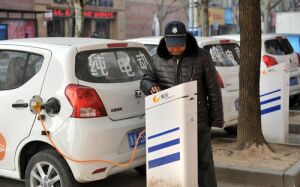China Is Leading The World's Boom In Electric Vehicles
In 2016, almost 95 million autos were made and sold globally, nearly all powered by an internal combustion engine (ICE). For the past 100 years, internal combustion engine powered vehicles, and readily available oil supplies have dominated autos. The winds of change are blowing, however, and many believe that the $2 trillion global auto industry is about to undergo a significant transformation as all-electric vehicles (EVs) begin to replace ICE vehicles. | This photo taken on March 2, 2016 shows a man charging an electric vehicle at a charging point in Linan, east China's Zhejiang province. |  Informations[1] Informations[1] |
While electric vehicles and plug-in hybrid electric vehicles (PHEVs) currently account for less than 1% of the cars produced annually, many believe that we are at the beginning of an “Electric Revolution.” In its recent comprehensive and authoritative report on the subject, Bernstein, a prominent Wall Street research firm, predicted that EVs could represent 40% of auto sales and 30% of the global car parc in 20 years. Likewise, UBS, a leading global financial services company, believes that a growing global electric vehicle fleet will be disruptive to gasoline demand by 2031.
China ahead of the curve
FUYANG, CHINA - JANUARY 03: A citizen wearing a mask walks in heavy smog on January 3, 2017 in Fuyang, China. |  Informations[2] Informations[2] | Why is China leading the way in embracing EV technology? The answer may simply be that China has no other choice. As a country, China has three fundamental paths it may follow. First, it can choose to live with a rapidly growing number of ICE powered vehicles on its roads, with all that implies as far as air pollution and energy independence. Second, the government can restrict the transportation choices of its citizens in an effort to balance environmental concerns. Or third, the country can embrace EV technologies that enable its citizens to have their cars without jeopardizing air quality in its cities. |







